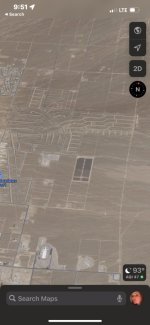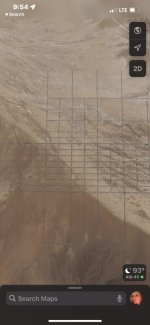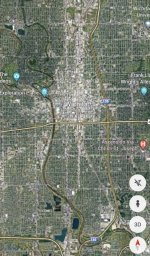The hypothesis pertaining to the notorious and secretive Area 51 will have nothing to do with aliens, or UFOs. On the other hand it will have everything to do with the previous spin of our civilization, old maps and legendary cities of the past.

This is not something we will ever be able to verify, but I figured a different Area 51 related hypothesis would not hurt. At first let us get some basic info on Area 51.
Around 1650s the North American Continent suffered the same fate the rest of the world did. To reference what I'm talking about use these links:

Sometime around 1650s, an event of great magnitude took place. This event drastically changed the outline of the Pacific North West area of the North America. Whether the area was entirely, or partially flooded, but the outline of the Continent did change. Some of the known coastal areas vanished with no trace.
The Seven Cities of Gold, also known as the Seven Cities of Cibola, is a myth that was popular in the 16th century. It is also featured in several works of popular culture. According to legend, the seven cities of gold could be found throughout the pueblos of the New Mexico Territory. The cities were Hawikuh, Halona, Matsaki, Quivira, Kiakima, Cibola, and Kwakina. While there have always been mentions of a seventh city, no evidence of a site has been found.

In 1539, Friar Marcos de Niza, a Franciscan priest, reported to Spanish colonial officials in Mexico City that he’d seen the legendary city of Cibola in what is now New Mexico. It was an electrifying statement - Spanish explorers who were scouring the New World for Native American treasure had heard persistent tales of the fantastic wealth of the so-called Seven Cities of Cibola.
I think this seventh missing city was Totonteac, and it was buried/destroyed in the event of the 1650s. I also think that our Area 51 is located directly over the top of this buried city. I understand that it is much easier to attribute all the secrecy to the UFO reverse engineering, but it appears that we could have our earthly things to reverse engineer.
In 1714, approximately 75 years after the area cities got destroyed, the following was published. Interesting that a lake was mentioned. Could it be our Groom Lake?

But it's texts like the 1628 one below, which have nothing to do with our Totonteac, but have the location mentioned due to the author's associations, that make me believe that Totonteac did exist.

Or like this 1664 text written in the language I do not know, yet the mere inclusion of Totonteac in this list gives its existence a certain credibility.

Or like these grid coordinates mentioned in 1677.

It sounds like our Totonteac had better constructed buildings as compared to Cibola.


And here is what the city of Cibola was described as.

TimingUnfortunately we cannot be sure of what happened when exactly. As long as narrative adjusters keep on providing us with bloopers like the one below, timing will always be a hard thing to figure out:

I am not going to copy/paste all the information available in the older books. Please help yourself using the below links. Click on the time span at the bottom of the linked pages and read for yourself.
Obviously, the official narrative has everything verified, and no such cities ever existed in the described state. Yet:
KD: Well, I just figured I will throw this hypothesis out there:
Area 51
The United States Air Force facility commonly known as Area 51 is a highly classified remote detachment of Edwards Air Force Base, within the Nevada Test and Training Range. According to the CIA, the correct names for the facility are Homey Airport and Groom Lake, though the name Area 51 was used in a CIA document from the Vietnam War. The facility has also been referred to as Dreamland and Paradise Ranch, among other nicknames. USAF public relations has referred to the facility as "an operating location near Groom Dry Lake".- General Info:
- Coordinates - 37°14′06″N : 115°48′40″W
- The base's current primary purpose is publicly unknown.
- The intense secrecy surrounding the base has made it the frequent subject of conspiracy theories and a central component to the UFO folklore.
- Although the base has never been declared a secret base, all research and occurrences in Area 51 are Top Secret/Sensitive Compartmented Information.
- On 25 June 2013, following a Freedom of Information Act request filed in 2005, the CIA publicly acknowledged the existence of the base for the first time, declassifying documents detailing the history and purpose of Area 51.
- History:
- Lead and silver were discovered in the southern part of the Groom Range in 1864.
- The English Groome Lead Mines Limited company financed the Conception Mines in the 1870s, giving the district its name.
- The interests in Groom were acquired by J. B. Osborne and partners and patented in 1876, and his son acquired the interests in the 1890s. Claims were incorporated as two 1916 companies with mining continuing until 1918 and resuming after World War II until the early 1950s.
- The airfield on the Groom Lake site began service in 1942 as Indian Springs Air Force Auxiliary Field, and consisted of two unpaved 5000-foot runways.
- The Groom Lake test facility was established in April 1955 by the CIA for Project AQUATONE, the development of the Lockheed U-2 strategic reconnaissance aircraft.
Historical Maps
It is important to understand that the North American continent went through some serious geological transformations. Our today's pseudo-scientists branded older maps as a sick fantasy of the poorly uneducated cartographers of the past. We are to believe that such esteemed scholars like Mercator (1512-1594), and Ortelius (1527-1598) were dumb and stupid enough to depict something they knew was not there.Around 1650s the North American Continent suffered the same fate the rest of the world did. To reference what I'm talking about use these links:
Sometime around 1650s, an event of great magnitude took place. This event drastically changed the outline of the Pacific North West area of the North America. Whether the area was entirely, or partially flooded, but the outline of the Continent did change. Some of the known coastal areas vanished with no trace.
The Seven Cities of Gold, also known as the Seven Cities of Cibola, is a myth that was popular in the 16th century. It is also featured in several works of popular culture. According to legend, the seven cities of gold could be found throughout the pueblos of the New Mexico Territory. The cities were Hawikuh, Halona, Matsaki, Quivira, Kiakima, Cibola, and Kwakina. While there have always been mentions of a seventh city, no evidence of a site has been found.
- In the 16th century, the Spaniards in New Spain (now Mexico) began to hear rumors of "Seven Cities of Gold" called "Cíbola" located across the desert, hundreds of miles to the north. The stories may have their root in an earlier Portuguese legend about seven cities founded on the island of Antillia by a Catholic expedition in the 8th century, or one based on the capture of Mérida, Spain by the Moors in 1150.
- The later Spanish tales were largely caused by reports given by the four shipwrecked survivors of the failed Narváez expedition, which included Álvar Núñez Cabeza de Vaca and a black moorish slave named Esteban Dorantes, or Estevanico. Eventually returning to New Spain, the adventurers said they had heard stories from natives about cities with great and limitless riches. However, when conquistador Francisco Vázquez de Coronado finally arrived at Cíbola in 1540, he discovered that the stories were unfounded and that there were, in fact, no treasures as the friar had described - only adobe towns.
- While among the towns, Coronado heard an additional rumor from a native he called "the Turk" that there was a city with plenty of gold called Quivira located on the other side of the great plains. However, when at last he reached this place (variously conjectured to be in modern Kansas, Nebraska or Missouri), he found little more than straw-thatched villages.
In 1539, Friar Marcos de Niza, a Franciscan priest, reported to Spanish colonial officials in Mexico City that he’d seen the legendary city of Cibola in what is now New Mexico. It was an electrifying statement - Spanish explorers who were scouring the New World for Native American treasure had heard persistent tales of the fantastic wealth of the so-called Seven Cities of Cibola.
- “It is situated on a level stretch on the brow of a roundish hill,” the friar said. “It appears to be a very beautiful city, the best that I have seen in these parts.” The priest acknowledged, however, that he had only seen the city from a distance and had not entered it because he thought the Zuni Indian inhabitants would kill him if he approached.
- But when a large and expensive Spanish expedition returned to the area in 1541, they found only a modest adobe pueblo that wasn’t anything resembling what the priest described. The expedition turned out to be a ruinous misadventure for those involved - including famed conquistador Francisco Vazquez de Coronado, who led it.
- “Virtually everyone, including the leader, returned to Mexico City heavily in debt,” says New Mexico author Richard Flint, who, with his wife, Shirley Cushing Flint, has written five books about Coronado. “A number of those people never recovered financially.”
- For five centuries, scholars have debated what de Niza saw when he claimed he’d found Cibola - or whether he simply told Spanish officials what they wanted to hear.
- The Seven Cities of Cibola
- The Viceroy Mendoza and the Seven Cities of Cibola - Historia del Nuevo Mundo
- Pánfilo de Narváez and Cabeza de Vaca, exploration of the Southern United States - Historia del Nuevo Mundo
- If you can find a life time depiction of Francisco Vázquez de Coronado, please share. I have my doubts about this gentleman, for there are too many historical fact which entirely depend on the literary results of his expedition.
Area 51 a.k.a. Totonteac
While there have always been mentions of a seventh city, no evidence of a site has been found. To be honest, I am not sure of what evidence of the first six cities they found. If anything, the narrative went out of their way to convince everybody that these cities never existed in the described state. Calculating the exact location of Totonteac, we should probably consider the Expanding Earth hypothesis in mind.I think this seventh missing city was Totonteac, and it was buried/destroyed in the event of the 1650s. I also think that our Area 51 is located directly over the top of this buried city. I understand that it is much easier to attribute all the secrecy to the UFO reverse engineering, but it appears that we could have our earthly things to reverse engineer.
- To be honest, I do not know how the count the cities, for we do appear to have seven. May be Cibola itself does not count as one.
- Hawikuh, Halona, Matsaki, Quivira, Kiakima, Cibola, and Kwakina.
Totonteac and Cibola
I have seen four various English language spellings of this city: Tonteac, Tototeac, Totonteac and Tontonteac. The actual city appears to have been a part of the Totonteac Regnum. Well, let us see what the older books have to offer in reference to our Totonteac and the Seven Cities of Cibola.In 1714, approximately 75 years after the area cities got destroyed, the following was published. Interesting that a lake was mentioned. Could it be our Groom Lake?
But it's texts like the 1628 one below, which have nothing to do with our Totonteac, but have the location mentioned due to the author's associations, that make me believe that Totonteac did exist.
Timing
I am not going to copy/paste all the information available in the older books. Please help yourself using the below links. Click on the time span at the bottom of the linked pages and read for yourself.
Obviously, the official narrative has everything verified, and no such cities ever existed in the described state. Yet:
- Coronado goes North-East, when the Quivira Regnum was located in the North-West.
- Just 277 miles North from the Groom Lake we have this interestingly designed 19th century Union Mine.
- And of course, California and Nevada are full of various National Parks, Military Installations and various other "off limits" areas.
KD: Well, I just figured I will throw this hypothesis out there:
- Area 51 was established to explore intellectual efforts of the previous spin of our civilization.
- Area 51 is located on top of a buried city, which could possibly be Totonteac.




